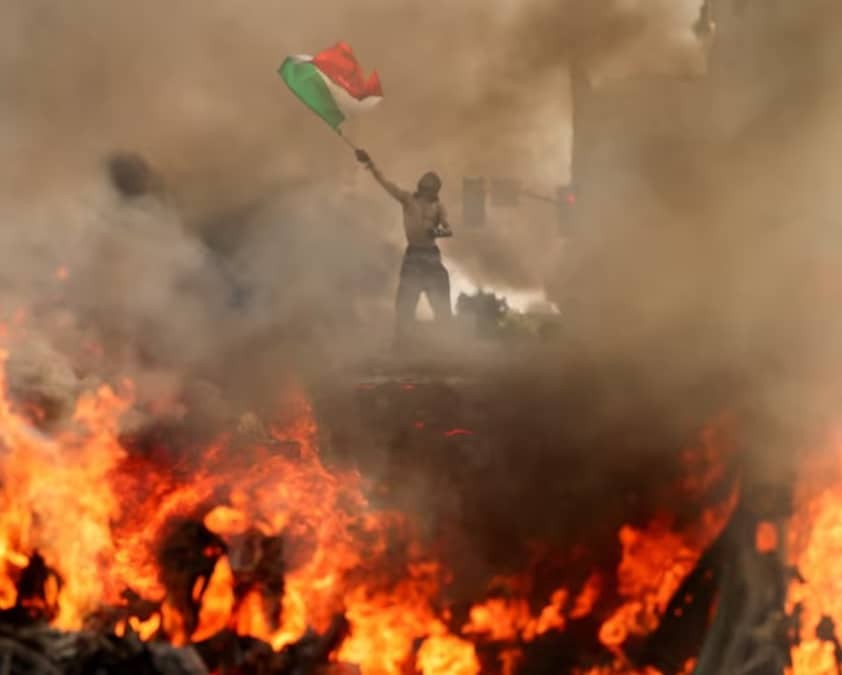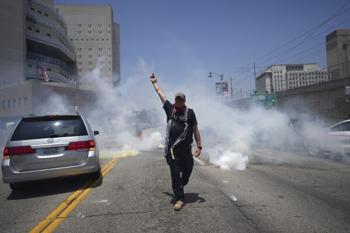Los Angeles Erupts in Protest as National Guard Rolls In Amid Immigration Raids
City on Edge as Troops Take to the Streets
Los Angeles found itself at the center of a mounting political and social storm over the weekend as thousands of protesters flooded the streets in response to the federal deployment of the National Guard. The city witnessed fiery scenes, including the torching of autonomous vehicles and a shutdown of the 101 Freeway, as demonstrators clashed with law enforcement amid a growing outcry over immigration enforcement.
Federal troops, clad in full riot gear, were stationed across key federal buildings, including the Metropolitan Detention Center. The deployment marked a rare and controversial instance of a president activating the National Guard in a state without its governor’s request, escalating tensions between state and federal authorities.
Protesters Confront Armed Troops
By midday Sunday, crowds had gathered downtown, chanting slogans like "shame" and "go home" at National Guard units armed with long guns and shields. The troops formed a human barrier in front of the detention center where many immigrants had been taken after a recent wave of federal raids.
When protesters moved closer to the guards, additional officers fired smoke canisters to break up the crowd. Soon after, the Los Angeles Police Department joined in, deploying rubber bullets and other crowd-control munitions, calling the assembly unlawful. As a result, demonstrators redirected their efforts, staging a blockade on the 101 Freeway, which was cleared only after hours of disruption by California Highway Patrol officers.
State-Federal Showdown Deepens
California Governor Gavin Newsom, in a strongly worded letter to President Trump, called the deployment "a serious breach of state sovereignty." He urged the president to withdraw the troops, accusing the federal government of fueling unrest rather than calming it.
Mayor Karen Bass echoed this sentiment, calling the situation a "chaotic provocation" and asserting that the show of military force served another agenda, far removed from the stated goals of public safety.
The president, however, defended the move, claiming California leaders had failed to contain the protests and asserting that a tough federal response was required to restore order.
A Controversial Federal Action
President Trump authorized the deployment of 2,000 National Guard members under a federal statute that allows intervention during civil disorder. He cited "violent individuals" in Los Angeles as the reason, promising a nationwide crackdown if unrest continued. Asked whether he would send regular military forces, the president left the door open, declaring, “We’re gonna have troops everywhere.”
The move marked one of the few times since 1965 that a state’s National Guard was mobilized without a governor’s request. The previous instance occurred when President Lyndon B. Johnson sent troops to protect civil rights marchers in Alabama.
Escalation Follows Immigration Raids and Arrests
The protests initially erupted Friday and intensified over the weekend, particularly in predominantly Latino neighborhoods like Paramount and Compton. Demonstrators clashed with federal agents setting up staging areas for immigration enforcement. Some hurled objects at Border Patrol vehicles, prompting agents to respond with tear gas, pepper balls, and flash-bangs.
The tension followed a weeklong series of immigration raids across Los Angeles that resulted in over 100 arrests. The situation worsened when a prominent union leader was detained for allegedly obstructing law enforcement efforts during a protest.
Though the current protests remain smaller than historic Los Angeles uprisings like the Rodney King riots or the 2020 George Floyd demonstrations, the federal response has been swift and forceful.
Marines on Standby as Tensions Mount
The administration’s response did not stop with the National Guard. Defense officials signaled a readiness to escalate further, with 500 Marines stationed at Twentynine Palms placed on alert. Defense Secretary Pete Hegseth warned of deploying active-duty Marines if violence persisted.
Statements from federal officials reflected a sharp tone. A top homeland security spokesperson criticized California leaders and protesters, accusing them of protecting criminals over law-abiding citizens. These comments further inflamed an already volatile environment.
Political Leaders Divided Over Federal Action
The National Guard deployment has drawn fierce reactions from political figures across the country. Senator Bernie Sanders condemned the president's actions as “a step toward authoritarianism,” while former Vice President Kamala Harris characterized the immigration crackdown and troop mobilization as part of a “cruel and calculated agenda.”
Harris, a Los Angeles resident, expressed support for protesters advocating for fundamental freedoms and human rights. Meanwhile, House Speaker Mike Johnson backed the president’s decision, criticizing state leaders for what he termed a lack of resolve in maintaining law and order.
Confusion and Misinformation Add to Chaos
Adding to the uncertainty, conflicting reports emerged about the timing of troop movements. While the president praised the National Guard for a "job well done" late Saturday night, the mayor of Los Angeles stated that troops had not yet arrived at that time, highlighting communication gaps between federal and local officials.
The road ahead for Los Angeles remains uncertain. As residents grapple with a heightened military presence and continue to voice their discontent, the city stands at a crossroads between federal authority and state governance.
What began as a protest against immigration enforcement has grown into a larger debate over civil liberties, state sovereignty, and the federal government’s role in local affairs. With both sides refusing to back down, Los Angeles may face more turbulence in the days to come.


